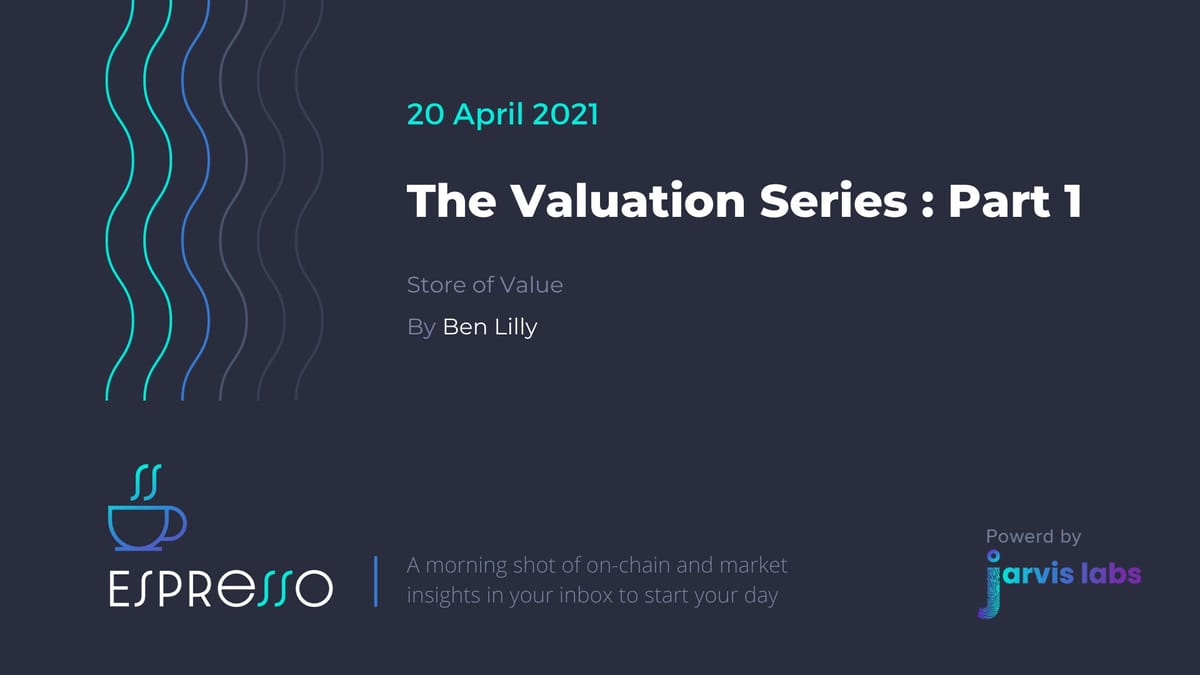The Valuation Series: Part One
Store of Value

Newcomers to the space are presented with a dizzying array of cryptocurrency assets.
These assets range from peer-to-peer currencies, application tokens, governance tokens, stablecoins, NFT assets and more.
Each type of asset gives the token unique traits that help determine its value.
Yet, to date analysts have chosen to evaluate these assets using traditional methods. I like to think of it as tightening a Philips head screw with a flathead - it might work in a few instances.
But more often than not, the metrics don’t fit.
It’s an issue our team has discussed from time to time, but not to the point where we were determined enough to tackle the issue head on.
When you take a moment and really start to break down the question of “what makes one token more valuable than another,” you quickly realize just how gigantic of a problem it is to work through.
After several days of brainstorming our conclusion was this…
The crypto market needed a fresh set of metrics for fundamental analysis.
Would it be something that we could start and finish in a week or so and consider the job done? No. We know this will be an ongoing development over the next couple years. As we gain confidence in some of our findings we look to introduce them here in Espresso to get feedback.
We’re open sourcing our crypto fundamental metrics to make them stronger.
Before we roll them out we’ll need to introduce some assumptions. We plan to go over the first one today. Let’s get to it…
Accruing Value
Stablecoins and NFTs are tied to legacy based currencies or assets such as government issued currencies, precious metals, art or tangible assets like a home. For that, traditional models work nicely. Which is why I’ll sort of disregard these when talking about how to determine a token’s valuation.
P2P currencies, decentralized application (Dapp) tokens and governance tokens are what we’ll be diving into.
These assets that are difficult to evaluate. And determining a model that can consider the unique traits can prove to provide the most return on one’s time.
Let me give you a quick example.
How often do we see transaction count and token velocity pop up in terms of a coin being viewed as having lots of value? Sure the network might have usage, but velocity on its own doesn’t lead to a higher coin price.
If you can easily buy and use a coin to pay for a service since it’s readably available, nobody has an incentive to hold the token over longer periods of time. You pay the admittance fee and move on.
It’s a topic that’s relatively well written about in crypto. And for brevity reasons I won’t be diving further into it here.
But if you’re like most and agree with this view on velocity, then you’re likely to think this argument applies to most governance and Dapp tokens.
Yet, much of these tokens are skyrocketing in price.
Which begs the question: what is it that leads to a token accruing value in the market?
There are a handful of traits we’re distilling, but the first trait we wan to talk about is Store of Value (SoV). It’s a term many have mentioned, but few have dissected.
To dissect it, let’s compare a home to bitcoin. And then money to bitcoin. In doing so we’ll learn more about the SoV trait that drives bitcoin’s value and why the SoV narrative is so important when it comes to a token.
Store of Value
SoV is a commodity, asset, or form of money that retains value and doesn’t depreciate. Meaning a non-collectible car doesn’t qualify nor a run of the mill home computer. These things lose value over time.
On the other hand, a home is generally regarded as having a store of value as it retains purchasing power in good or in bad times.
This makes it an asset that people want to hold on to.
And what’s unique about a home is that an owner can draw upon its value via financial tools. A great example of this is a home equity line. This enables an owner to gain access to credit and purchasing power without selling the home.
This makes it a desirable asset.
And in the last few years, we’ve witnessed bitcoin gain similar financial tooling that enables this home equity line of behavior.
This is making bitcoin more of a store of value asset than ever before. And in the coming years if bitcoin reduces the volatility it experiences - which I chalk up to bitcoin being a new asset class - then this SoV narrative will only strengthen.
So if we ignore this volatility for a moment, we can focus on another main difference between the two, which is the assets liquidity and maintenance.
The maintenance is rather straightforward… Your home requires repairs over time so you’ll need to spend money to retain is value. Bitcoin on the other hand is very minimal maintenance.
So instead of focusing on maintenance, we can instead focus on liquidity.
A home might take longer to find a buyer for a willing seller. This is especially true if the home is rather unique or a lot more expensive relative to the average home price.
Bitcoin on the other hand does not fall victim to this uniqueness since each token is fungible. This means when buying bitcoin on the market, it doesn’t matter which one you buy for the most part.
Then there’s also the fact it’s a highly liquid trillion dollar market. Selling a bitcoin can be down in a matter of minutes, and the price is easy to figure out.
The high liquidity bitcoin enjoys also gives it attributes similar to money.
And its for these reasons bitcoin straddles the frontier of being a SoV asset in how it has similarities to both a home and a currency.
As more people view bitcoin as this type of SoV asset, the more buyers we will see. It’s currently a main driver for a lot of the corporate buyers of late. And it’s a trend that isn’t likely to stop anytime soon.
The key is, how do we measure this stat?
That’s where the next assumption comes in. It’s about productivity. And by measuring how productive an asset is, we begin to see not only how a token accrues value, but how to measure this SoV trait.
Until the next part of the series…
Your Pulse on Crypto,
B
P.S. - This is the the first part of the Valuation Series. To read more about the Valuation Series, you can read the post where we introduce it - here. We will slowly unveil the valuation model we are building behind the scenes as we build it. We’re literally working through this monumental tasks as I write these words today.





